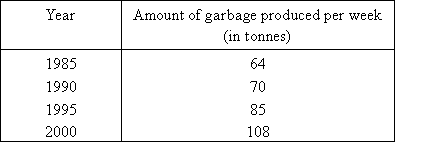Project 3.1 Garbage Collection and Disposal
Garbage is produced in every home and industry; and most of the garbage
is dumped into the ground. Often, this creates a pollution problem. The
cost of garbage collection and disposal is rising at an alarming rate. The
cost of disposing garbage in landfills had gone up considerably in many
areas. Local councils make a provision of a large amount of money for the
restoration of the current landfills sites and the preparation of the new
sites for use in the future.
Local councils need to predict the amount of garbage that will need
placement in order to make financially feasible plans for the future.
The data on garbage production in a particular area is as follows:

Let the variables be defined as follows:
A = Amount of garbage produced per week (in tonnes)
t = Time in years
1. Use the given data to complete the following table:

2. Plot the data collected.
3. Draw a line of best fit to the data.
4. Formulate an algebraic model for the amount of garbage
produced per week.
5. Predict the amount of garbage that will be produced weekly in
the year 2005.
6. The plans for the waste disposal of a particular area include
building an incinerator that will be able to handle the garbage for the
whole area. About 10% of the waste are bottles and cans that can be
recycled. Find the minimum capacity of the incinerator in the year 2005.
Assume that bottles and cans will not burn.
7. The proposed incinerator has a burning capacity of 130 tonnes
a week. According to your projections, will this incinerator be able to
handle the garbage needs of the particular area in the year 2010? |